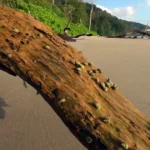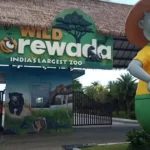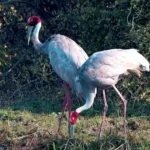Covering an area of around 70.13sq km Laokhowa Wildlife Sanctuary is located on the southern part of the Brahmaputra River in Nagaon District of Assam, India. It was declared as a buffer zone of the Kaziranga Tiger Reserve in 2007 and become an integral part of the larger Laokhowa-Burachapori ecosystem. It is a part of the Brahmaputra valley.
Laokhowa Wildlife Sanctuary – What to Expect
Mammals: The sanctuary boasts a diverse range of wildlife. It is a habitat place for the majestic great Indian one-horned rhinoceros, graceful elephants, royal Bengal tigers and powerful Asiatic water buffaloes. Other fascinating animals found in the Laokhowa Wildlife Sanctuary include the elusive barking deer, sleek fishing cat, agile leopard cat, mysterious civet and spirited wild pig.
Birds: With over 225 bird species, Laokhowa Wildlife Sanctuary is a haven for bird enthusiasts.
Fishes: The sanctuary is a breeding ground for about 39 fish species.
Reptiles: A total of 14 reptile species were recorded in the Sanctuary.
Amphibians: Water bodies within the sanctuary provide ideal habitats for amphibians with 9 recorded species found in the area.
Flora: Apart from its fauna, Laokhowa is also rich in flora, with diverse plant species including grasslands, tropical moist deciduous forests, and semi-evergreen forests.

Laokhowa Wildlife Sanctuary Map and Boundary
Laokhowa Wildlife Sanctuary spans an area of 70.1 sq. km in the Nagaon district. The sanctuary is surrounded by human-dominated areas on all sides except for the north. It is located on the extreme northern boundary of the Nagaon district and the southern boundary of the Sonitpur district.
Geographical Coordinates:
Latitude: Laokhowa Wildlife Sanctuary is located between latitudes 26°28’31.85″N to 26°32’13.95″N.
Longitude: The sanctuary spans longitudes 92°37’57.91″E to 92°47’23.27″E.
Elevation: The sanctuary elevation varies from 35 to 60 meters above mean sea level.
Boundary:
1. North: Laokhowa Wildlife Sanctuary is bordered by Burachapori Wildlife Sanctuary, Lawkhowa suti (wetland), Haldia suti (wetland), and Mara suti (wetland) in the north.
2. East: The sanctuary is bounded by the Nagaon-Silghat PWD road in the east.
3. South: Leterijan (wetland) marks the southern boundary of Laokhowa Wildlife Sanctuary.
4. West: A forest road defines the western boundary of the sanctuary.
The sanctuary together with Burasapori Wildlife Sanctuary within its fringe has 1 forest village, 7 tanungya villages and 33 fringe villages. The region is commonly involved in cattle rearing with a significant number of 24,846 cows, 23,142 bullocks and 1025 buffalos grazing in the two sanctuaries as per the 2013 survey conducted by the Nagaon Wildlife Division. The Laokhowa Wildlife Sanctuary is managed by the Divisional Forest Officer, Nagaon Wildlife Division.

Laokhowa Wildlife Sanctuary Geography
Laokhowa Wildlife Sanctuary located in the Brahmaputra Valley floodplain is a biological variability region encompassing a range of ecosystems including grasslands, woodlands, wetlands and riparian forests.
1. Climate: Laokhowa Wildlife Sanctuary experiences the prevailing sub-tropical monsoon climate. Summer temperatures in the region can reach an utmost of approximately 33.8°C providing warm and humid conditions for the sanctuary’s flora and fauna. In contrast, during winter the minimum temperature drops to around 9.6°C offering cooler conditions.
The averages annual rainfall in the sanctuary is about 2000 mm with the majority occurring during the rainy season from June to September. The relative humidity scales between 65% and 95% with the lowest levels observed during the winter months.
2. Soil Composition: The soil in Laokhowa Wildlife Sanctuary is predominantly composed of alluvial deposits from the Brahmaputra River. This fertile soil is characterized as clay loam mixed with silt providing a favorable environment for a diverse range of plant species. The alluvial nature of the soil, sourced from the river, contributes to its richness and suitability for supporting the sanctuary’s vegetation.
3. Flood: As part of the Brahmaputra Valley floodplain, Laokhowa Wildlife Sanctuary is susceptible to annual monsoon-induced floods. The sanctuary’s low-lying areas are particularly prone to outpouring with approximately 50% to 70% of the landmass affected by flooding each year. The gentle slope gradient from south to north and east to west in the region further amplifies the flood risks within the sanctuary.

Laokhowa Wildlife Sanctuary Conservation History
Kaziranga and Orang National Parks along with Laokhowa Wildlife Sanctuary and Burachapori Wildlife Sanctuary form the central Assam conservancy landscape connected by the Brahmaputra River and its islands locally known as chars. This wildlife migratory corridor has been used by tigers and rhinos as documented by Ahmed et al. (2010) and Ojah et al. (2011). Rhinos have been observed visiting LWLS and BWLS during their migrations between Kaziranga and Orang. To maintain connectivity and facilitate the meta-population of tigers between the two national parks, LWLS and BWLS were declared buffer components of the Kaziranga Tiger Reserve in 2007.
Back in the early 1900s, this sanctuary along with Kaziranga was recognized as a Proposed Reserve Forest primarily because of its population of one-horned rhinoceroses. In 1955, there were 41 great one-horned rhinos in the area. In the early 1980s, the rhino population in Laokhowa had surpassed 70 individuals.
However, during the early 1980s, the region faced political unrest known as the Assam Agitation. This unstable situation led to a devastating event in 1983 when poachers took advantage of the turmoil and poached over 40 rhinos within a few weeks. The surviving rhinos were forced to flee to safer Protected Areas like Orang and Kaziranga.
Efforts were made to restore the rhino population in Laokhowa Wildlife Sanctuary. As part of the Indian Rhino Vision 2020 (IRV 2020) program, two rhinos a mother and her daughter were reintroduced to the sanctuary from Kaziranga National Park in 2016. But both animals passed away within a few months due to natural causes.
Biodiversity in Laokhowa Wildlife Sanctuary
1. Large Mammals:
The Laokhowa Wildlife Sanctuary provides a habitat for various large mammals including the majestic Asiatic wild buffaloes, the iconic Royal Bengal tigers and the magnificent elephants. These charismatic species contribute to the rich biodiversity of the sanctuary.

2. Herbivores in Alluvial Grasslands:
The alluvial grasslands of Laokhowa Wildlife Sanctuary sustain a diverse range of herbivores. Species such as sambar (Rusa unicolor), barking deer (Muntiacus muntjak) and hog deer (Hyelaphus porcinus) thrive in these grasslands, relying on the abundant vegetation for their survival.
3. Rare and Endangered Species:
Laokhowa Wildlife Sanctuary is a haven for numerous rare and endangered species. The sanctuary harbors a variety of small cats, reptiles, turtles, butterflies and nocturnal creatures like binturong and slow loris.
4. Wetlands and Avian Diversity:
The sanctuary boasts both perennial and seasonal wetlands that serve as vital breeding grounds for numerous local fish species and important bird species. Each winter, a plethora of migratory birds including waterfowls, grace the rich wetlands of Laokhowa Wildlife Sanctuary. These wetlands have earned recognition as Important Bird Areas (IBAs) by Birdlife International (IN393), emphasizing their significance for avian conservation.
The sanctuary complex hosts approximately 290 bird species as documented within the Laokhowa Wildlife Sanctuary complex (NWLD-LBCS 2014). Notably, the critically endangered Bengal florican (Houbaropsis bengalensis) finds refuge in this sanctuary while thousands of Blue-tailed Bee-eaters (Merops philippinus) make it their breeding ground.
5. Habitat and Fodder Availability:
Within the LBWLS complex, specific regions such as Kasodhora, Koroitoli, Hijalbari, Kherbari, and south of Jhaoni are categorized as highly suitable habitats. These areas, along with the Dhania suti region extending up to Bogoriati and Baghmari in Burachapori Wildlife Sanctuary form contiguous zones with Laokhowa Wildlife Sanctuary in Arimari, Lathimari,and Palashtoli, up to Bogoriati. The central region of the sanctuary complex is where these suitable habitats are predominantly found.
6. Water Bodies and Rhinos:
The presence of perennial and seasonal water bodies within the sanctuary offers essential resources for rhinos. These water bodies serve as prime locations for rhinos to wallow and quench their thirst. Abundant aquatic plants such as Hemarthria compressa, Arundo donax, Ipomea aquatica, and Hymenachne pseudointerrupta flourish in these wetlands, providing nutritious fodder for rhinos.
7. Grassland and Fodder Composition:
Rhino fodder dominates the grassland patches of Laokhowa Wildlife Sanctuary. Species like Imperata cylindrica and Saccharum ravannae form the primary vegetation offering a rich food source for rhinos. Other palatable species including Cynodon dactylon, Saccharum spontaneum, Vetiveria zizanioides along with trees like Ziziphus zuzuba, Lagerstroemia flos reginae, and Barringtonia acutangula, contribute to the diverse and abundant fodder base available in the sanctuary.

Activities at Laokhowa Wildlife Sanctuary
1. Bird & Butterfly Watching:
Laokhowa Wildlife Sanctuary’s landscape is characterized by wetlands, grasslands and woodlands besides the Brahmaputra River. This varied habitat attracts a wide variety of local and seasonal migratory bird species making it an excellent site for observing and documenting birds and butterflies. The area’s richness in flora and fauna offers ample opportunities to study the diverse bird species and explore the ecological interactions of butterflies within the sanctuary.

2. Nature Trails and Treks:
The diverse landscape of Laokhowa Wildlife Sanctuary presents abundant opportunities for nature enthusiasts to embark on thrilling nature trails and treks. Starting from Dhania Range Office of Burachapori Wildlife Sanctuary trek through Thulomukoli with its unique Hijol tree vegetation. Pass the Koroitali grasslands to witness a large colony of Bee-Eater birds along with other grassland birds, snakes, monitors and mammals.
Orchid enthusiasts will find many varieties in this area. Continue to the Jhaoni region approaching the Brahmaputra River, where you can spot riverine birds, turtles and Gangetic Dolphins. Reach Basabari where the landscape transforms into thick woodlands and glimpse the Laokhowasuti, the common border of Laokhowa & Burhachapori Wildlife Sanctuary. The trek culminates here before returning to Dhania.

3. Photography:
The diverse and scenic landscape of Laokhowa Wildlife Sanctuary extends abundant photography opportunities. With its rich flora and fauna, photographers can capture the sanctuary’s natural beauty through their lenses. The sanctuary’s varied habitats including wetlands, grasslands, woodlands and the Brahmaputra River extend a diverse backdrop for capturing stunning shots of birds, mammals, reptiles, and insects. From vibrant orchids to graceful birds and serene wetlands, Laokhowa Wildlife Sanctuary offers a captivating setting for photographers to showcase their creativity and capture the essence of this remarkable sanctuary.
4. Study Tours, Excursion and Research Activities:
Laokhowa Wildlife Sanctuary’s rich biodiversity and ecology create an ideal environment for study tours, excursion trips and research activities. This unique landscape extends ample opportunities for researchers to explore and understand the intricacies of its diverse ecosystems, contributing to the conservation efforts and furthering our knowledge of this remarkable region.
Best Time to Visit Laokhowa Wildlife Sanctuary
The ideal time to visit Laokhowa Wildlife Sanctuary is during the winter months from November to March. With sub-tropical monsoon climate summers are hot and humid reaching temperatures up to 33.8°C while winters extend cooler environments with minimum temperatures around 9.6°C. The sanctuary receives an average annual rainfall of 2000 mm mostly during the rainy season from June to September. Visiting during winter ensures pleasant weather, lower flood risks and opportunities to witness diverse wildlife and vegetation.
How to Reach:
Airports: The nearest airports from Laokhowa Wildlife Sanctuary to Nagaon town are Guwahati (120 km), Tezpur (68 km) and Jorhat (186 km).
Railway Stations: The closest railway stations are Haiborgaon (1 km), Chaparmukh (30 km) and Guwahati (120 km). Road Connectivity: There are regular bus services available from all cities and towns to Nagaon. The NH 36 and NH 37 pass through the heart of Nagaon town. It is important to note that all the distances mentioned are to Nagaon town. The Nagaon Wildlife Division is situated at Katimari, Nagaon approximately 2.5 km away from Nagaon town. Bus services are available from Nagaon to Laokhowa (28 km), Lailuri (25 km), Singimari (20 km), Sutirpar (26 km) and other important locations.
Food & Accommodations:
In Nagaon, Kaliabor and Tezpur towns there are various hotels, lodges and resorts available both owned by the government and private groups. For eco-tourists who are interested in experiencing the local cuisine prepared by the local communities, they can request this in advance and place their food orders during the trip booking process.
Conclusion
With diverse ecosystems and fertile alluvial soil located in the Brahmaputra Valley floodplain, the Laokhowa Wildlife Sanctuary holdup a wide range of flora and fauna. The sanctuary offers opportunities to witness abundant wildlife including migratory birds and vibrant vegetation. The sanctuary is a captivating destination that showcases the beauty of nature and emphasizes the importance of conservation.
FAQ
a.) What is Laokhowa Wildlife Sanctuary famous for?
Laokhowa Wildlife Sanctuary famous for the great Indian-one horned rhinoceros, graceful elephants, royal Bengal tigers, powerful Asiatic water buffaloes and more than 225 species of birds. Other fascinating animals found in the Laokhowa Wildlife Sanctuary include the elusive barking deer, sleek fishing cat, agile leopard cat, mysterious civet and spirited wild pig.
b.) On which river is Laokhowa Wildlife Sanctuary?
Laokhowa Wildlife Sanctuary is a protected area located on the southern bank of Brahmaputra River in the Nagaon District of Assam, India.
c.) Which is the oldest wildlife sanctuary in Assam?
Garampani means hot water, it come from the local language. Garampani Wildlife Sanctuary is the oldest sanctuary containing hot water springs and waterfalls located in the Karbi Anglong district of Assam, India.
d.) When was Laokhowa Wildlife Sanctuary established in the year?
Laokhowa Wildlife Sanctuary is a 7,011-hectare (70.11 square kilometers) protected area situated in the Nagaon district of central Assam, India. Designated as a game reserve in 1907, this sanctuary was established to protect and conserve the population of the Indian One-horned Rhinoceros (Rhinoceros unicornis), a species of rhinoceros known for its single horn and distinctive appearance.
You May Also Like











2 thoughts on “Laokhowa Wildlife Sanctuary”